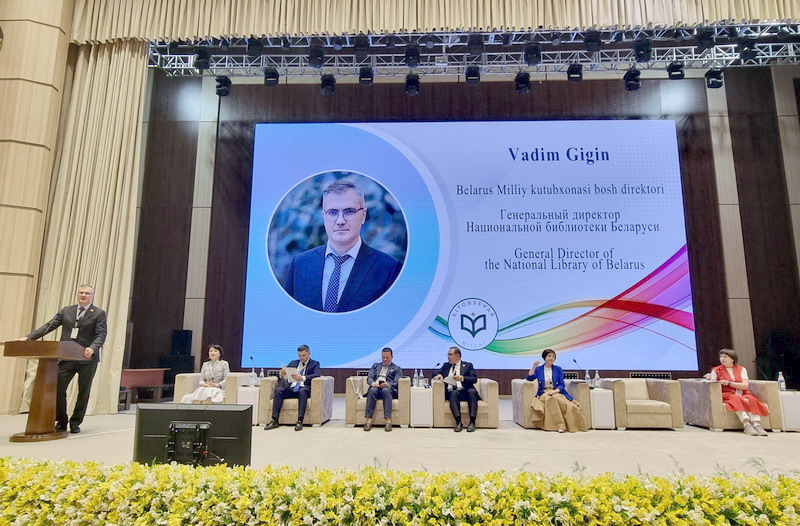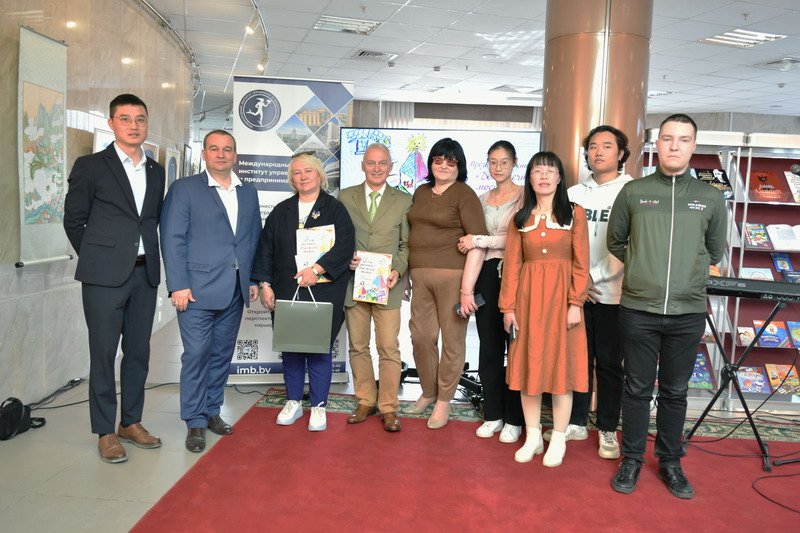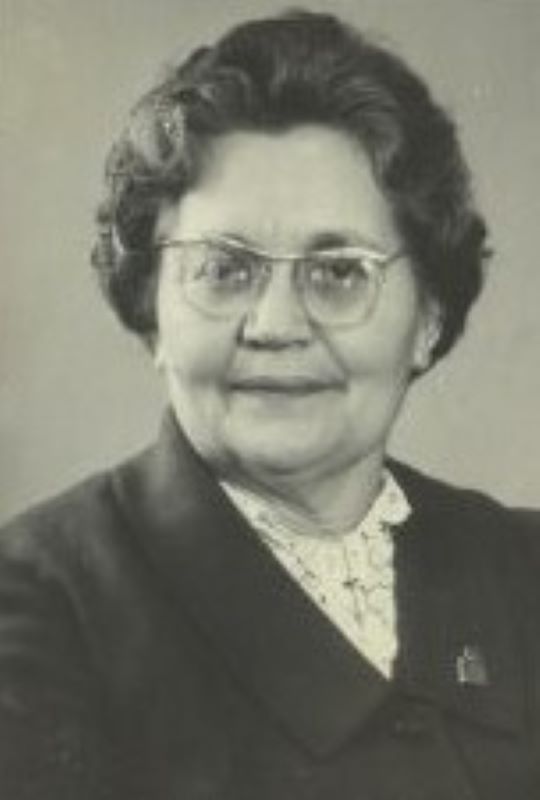The National Library continues to present materials about the art life of Belarus that were published a hundred years ago in Belarusian newspapers.
About the "new" and "old" art: dialogues with the audience
The newspapers of the time published polemical articles on the relationship to the "old" and "new" art, and announcements of forthcoming disputes, lectures and evenings.
V.S. Dmitriev, who proclaimed the dictatorship of the proletariat in art as well, published a sort of futurist manifesto in the February 1919 issue of the newspaper Zviazda:
Today is the anniversary of the Red Army. <...> It is not a holiday of peace, but a holiday of war, a holiday in time of war and for war. <...> And we artists, when we took on the task of decorating the city, did not intend to please and amuse the strolling public at all. <...> We ourselves are fighters, we are also setting the same world on fire[,] the first spark of which is our Red Army – not only in the field of art. <...> We will also relegate our burgeois, our right-wing and middle-class artists, our "patented" artists, to the fourth category, to apprenticeship to genuine proletarian masters. <...> We[,] artists[,] have given up our personalities, we kill ourselves, we only combine simple lines, simple planes... And in these schemes we[,] individual artists[,] cannot be distinguished – for here is the beginning of mass art, for here the line between the artisan and the "patented" artist has already disappeared.
Dmitriev V.S. Long live communal art.
Zviazda, 1919, February 23, p. 2
In the following article, the author gives a radical answer to the question of why collect art treasures:
But is it to appreciate and admire them that we collect the artworks? Quite the contrary, to disarm them, to weed out the contamination from them, to turn them from monetary value into a mere scientific object. Let historians and scholars analyse these artefacts; to know the past is necessary if we are to stand firm in the present[,] but to study the past[,] is far from worshipping it or imitating it. <...> IIt must be clearly understood that now, in a socialist state, monuments of arts are absolutely not something 'good' <...>. <...> It is impossible to decorate our palaces, halls and schools with this sort of `good', <...> this `good' must be disarmed – collected and locked up in prisons-museums. We are not barbarians; the conscience of the cultural man of the twentieth century will not allow us to leave the creations of art to be torn down and destroyed; we will hasten to collect them in suitable buildings, with sufficient light, warmth and air. <...> Who needs this rubbish other than scholars and historians? So let's collect it for our future art science! Let's make it a good cause!
Dmitriev V. Why art repositories are needed.
ЗZviazda, 1919, February 26, p. 1
Note that the author, despite his attitude towards the artworks of the past as unnecessary "junk", nevertheless persisted in convincing his readers that it should be kept for science. Let's agree that this is a very sensible thought in the whirlwind of those revolutionary events.
In the same line of polemical speeches in the newspapers is Chagall's article "Art Notes" published in the Viciebsk Leaflet [4].
The artists also made direct contact with the audience, not leaving their attitude to their "new" art to chance.
In Babrujsk an evening was announced "to acquaint the public in Babrujsk with works of art, organized by local artists and artists from Petersburg" [9]; in Viciebsk – "the 1st art meeting-debate about art" with a report by Marc Chagall [5].

 During the National Exhibition, the Section of Fine Arts of the Province People's Education Department, "in response to the interest of the general public in art matters, decided to arrange a series of lectures" [11]: "The Newest Trends in Painting (Impressionism, Cubism and Futurism)" by Kazimir Malevich [10]; an explanation of the paintings at the exhibition [13] and "The Greco Painter" by Aleksandr Romm [12].
During the National Exhibition, the Section of Fine Arts of the Province People's Education Department, "in response to the interest of the general public in art matters, decided to arrange a series of lectures" [11]: "The Newest Trends in Painting (Impressionism, Cubism and Futurism)" by Kazimir Malevich [10]; an explanation of the paintings at the exhibition [13] and "The Greco Painter" by Aleksandr Romm [12].
Aleksandr Romm (1886–1952), art critic, translator, artist. Following Chagall's invitation, he moved to Viciebsk (1918–1922), worked in the fine arts sub-department of the provincial department of public education, chaired the Commission for the Protection of Ancient Artefacts and Art Objects and taught art history at the Viciebsk People's Art School.
Interest in the culture and art of Belarus
Here are a few more publications that testify to the rise of national self-consciousness and interest in Belarusian culture and art.
A 1918 newspaper reported:
On the initiative of interim Marshal of the People's Secretariat Ja. Varonka, painter S. Valansievich paints a gallery of portraits of Belarusian writers and scholars: Bahushevich, Nislukhouski, Marcinkevich, Ja. Kolas, Ja. Kupala, M. Bahdanovich, F. Skaryna and others. This will now be the only gallery, as the previous collections were lost during the retreat of the Russian army in 1915.
Chronicle. Gallery of Belarusian writers and scholars.
Volnaja Belarus, 1918, 9 June, p. [6]
In the newspapers of the 1920s, we find a lot of interesting information about Belarusian artists or paintings dedicated to Belarus.
In one of the issues of the newspaper The Rune of Belarusian Literature and Art in 1920, a landscape by J. Drazdovich was published [14].
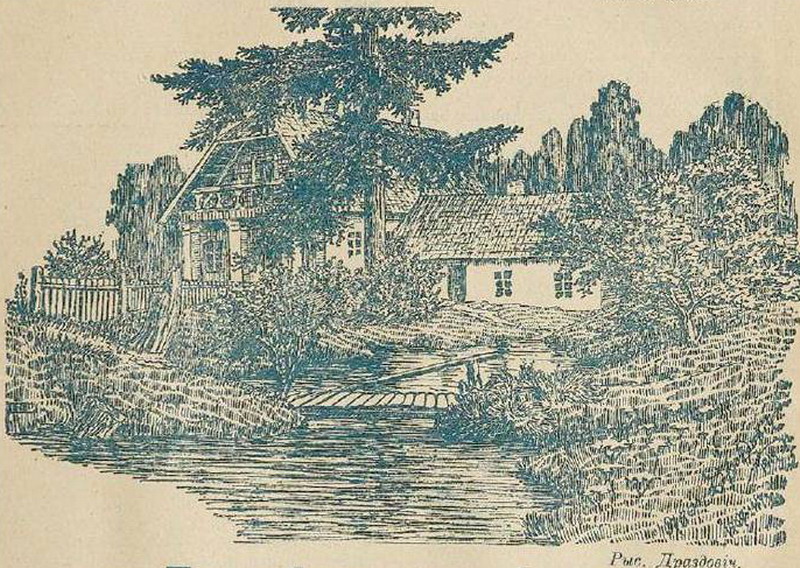
Ja. Drazdovich. Landscape
In 1922, another newspaper carried an article about the artist's drawings:
<…> several exhibits are in the Belarusian Museum, the bookshop and the Civic Assembly. Jaz[ep]. Drazdovich, despite his nomadic lifestyle and difficult financial situation, is still doing a lot. Each year brings something new to the table. It's about time he thought about displaying his drawings.
The author of the article assessed the artist's works:
<…> His graphic work is very impressive. The portraits of the Old Belarusian princes reveal the power and will of our ancestors. The execution is complete. Apparently, the artist studied a lot to create the image of the Polack prince. A lot of artistic flair and imagination is invested in the drawings depicting old settlements, primitive houses of Belarusians, etc. Here Drazdovich managed to capture the origins of architectural art, to hear the Belarusian style, the power of creativity in the constructions of our ancestors. As for the other images made with paint, you won't understand them without an explanation from the author. Very confusing symbolism, a lot of it naive, sick and alien sentiment.
Drazdovich's paintings.
Our Future, 1922, 16 December, p. 4
Jazep Drazdovich (1988–1954) – Belarusian painter and graphic artist, teacher and ethnographer, known for his graphic sketches of nature and castles in Belarus, as well as fantasy-themed paintings.
The issue of one of Repin's paintings relating to Belarus was raised on the page of the newspaper Dziannica:
<…> A few years ago, a group of Belarusian figures negotiated with the famous painter Ilya Repin, who lives in the "Penatas" in Finland, about providing the Belarusian National Museum with a copy of his painting "Belarusian", which is held in the Russian Museum of Emperor Alexander II in Petrograd. It is known that Repin granted Belarusian organisations the right to reproduce this painting. Today, due to fears for Repin's life, the founders of the Belarusian Cultural Educational Society "Fatherland" have renewed their correspondence with the famous artist regarding the same painting, the submission of which to the Belarusian National Museum should mark an event of great importance.
A little about everything. “Belarusian”, painting by I. Repin.
Dzyannica, 1918, 30 October, p. 4
Ilya Repin (1844–1930) depicted a wealthy farmer Sidsr Shaurou from a village near the artist's estate Zdravniova (now the Viciebsk region). The painting is kept in the State Russian Museum, St. Petersburg.
However, the negotiations were unsuccessful, and a copy was not created.
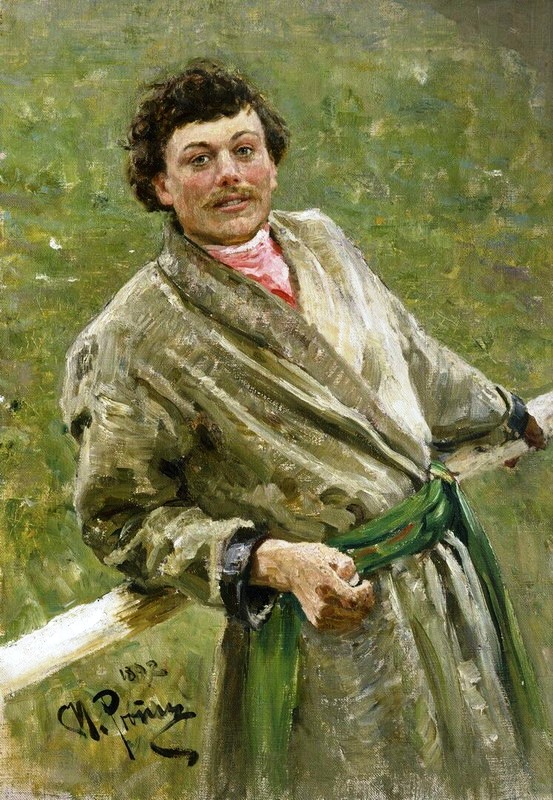
I. Repin. Belarusian, 1892
Several drawings of Mir Castle by an unknown author were published in a supplement to the Novy Vestnik newspaper [3].
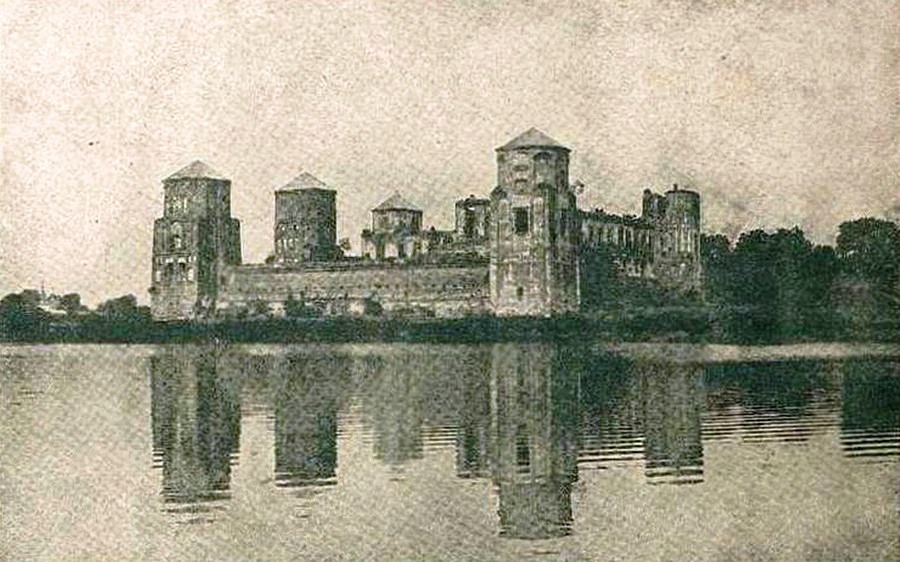
Mir Castle, view from the lake (author unknown)
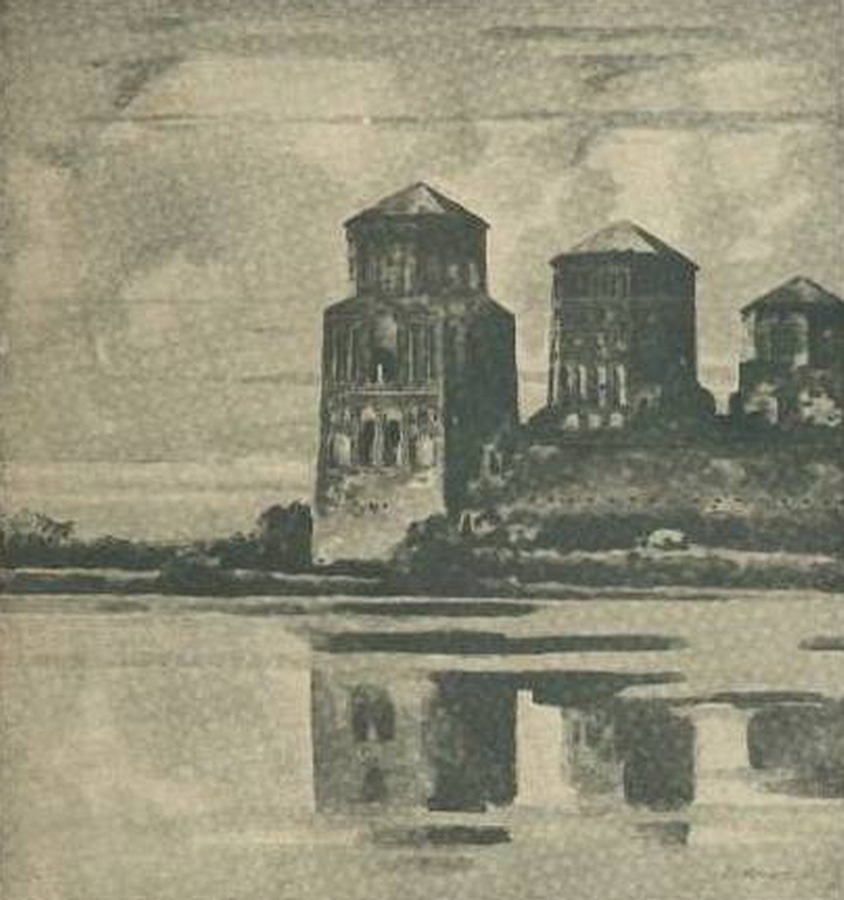
Mir Castle (author unknown)
List of sources cited:
- Хроніка. Галерэя беларускіх пісьменнікаў і вучоных // Вольная Беларусь. – 1918. – 9 чэрв. – С. [6].
- Аб усім па троху. Картина И. Репина – «Белорус» // Дзянніца. – 1918. – 30 кастр. – С. 4.
- Мирский Замок: [рисунки] // Новый вестник. – 1918. – 17 нояб. – (Прилож. № 28.). – С. 5–6. – (Автор неизвестен).
- Шагал, М. Художественные заметки / М. Шагал // Витебский листок. – 1919. – 8 янв. – С. 1.
- Художествен<ный> диспут // Витебский листок. – 1919. – 6 февр. – С. 3.
- Дмитриев, В. С. Да здравствует коммунальное искусство / В. С. Дмитриев // Звезда. – 1919. – 23 февр. – С. 2.
- Дмитриев, В. Почему необходимы художественные хранилища / Вс. Дмитриев // Звезда. – 1919. – 26 февр. – С. 1.
- Горецкий Народный дом // Луч Интернационала. – 1919. – 25 апр. – С. 4.
- Бобруйск. Вечер художников // Коммунист. – 1919. – 13 июля. – С. 3.
- Лекция художника Малевича // Известия Витебского губернского Совета крестьянских, рабочих, красноармейских и батрацких депутатов. – 1919. – 15 нояб. – С. 4.
- Художественная жизнь // Известия Витебского губернского Совета крестьянских, рабочих, красноармейских и батрацких депутатов. – 1919. – 16 нояб. – С. 4.
- Лекция А. Г. Ромма // Известия Витебского губернского Совета крестьянских, рабочих, красноармейских и батрацких депутатов. – 1919. – 22 нояб. – С. 4.
- Объяснение картин // Известия Витебского губернского Совета крестьянских, рабочих, красноармейских и батрацких депутатов. – 1919. – 22 нояб. – С. 4.
- Драздовіч, Я. [Пейзаж]: [малюнак] / рыс. Я. Драздовіч // Рунь беларускай літаратуры і мастацтва. – 1920. – 9 мая. – С. 5.
- Малюнкі Я. Драздовіча // Наша будучыня. – 1922. – 16 снеж. – С. 4.
You can explore primary sources (the Zviazda newspaper and others) by visiting the National Library of Belarus or by purchasing the electronic edition "Establishment of Belarusian Statehood: On the Pages of Belarusian Newspapers of 1917–1922", which contains electronic copies of 2,400 issues of newspapers (almost 80 titles) published in 1917–1922 in the territory of modern Belarus or outside it, but about it, on two discs.
The set of CDs "Establishment of Belarusian Statehood: On the Pages of Belarusian Newspapers of 1917–1922" can be purchased by subscription or at the kiosk on the 1st floor near the main entrance. The kiosk works in accordance with the Library opening hours.
Information and Analytic Activity Department





